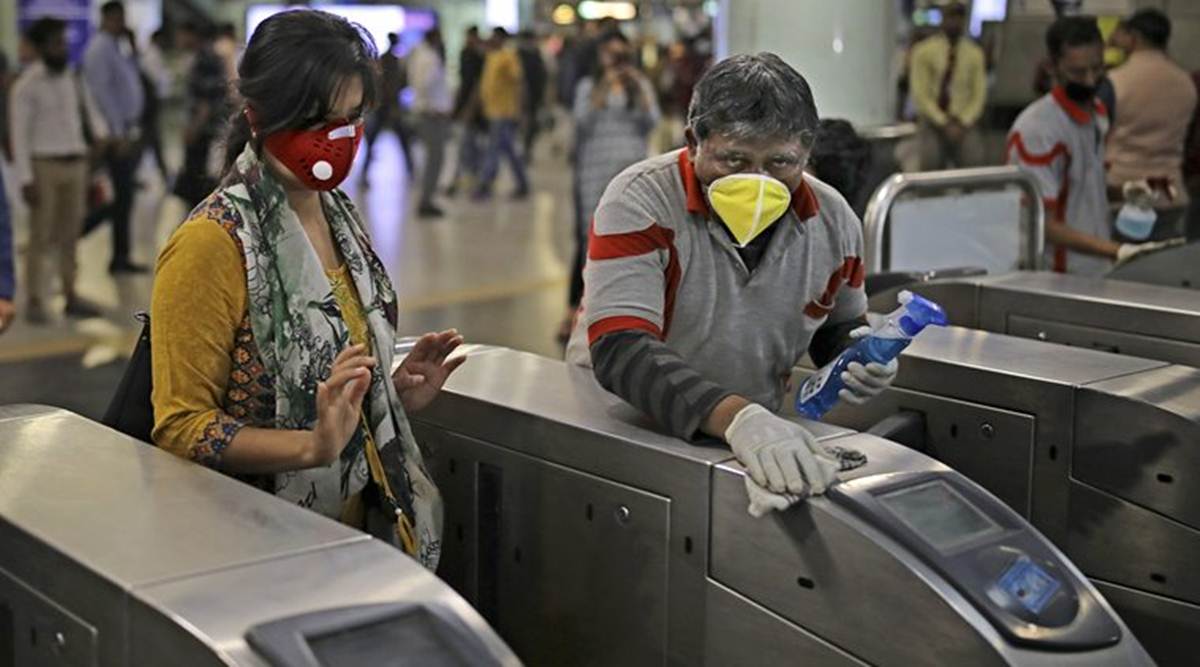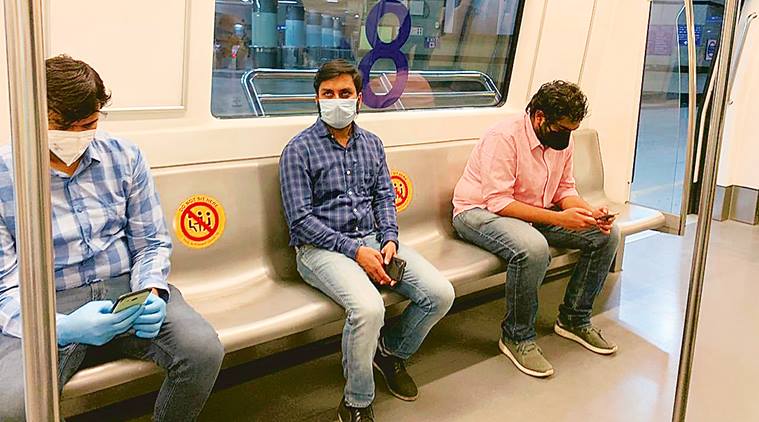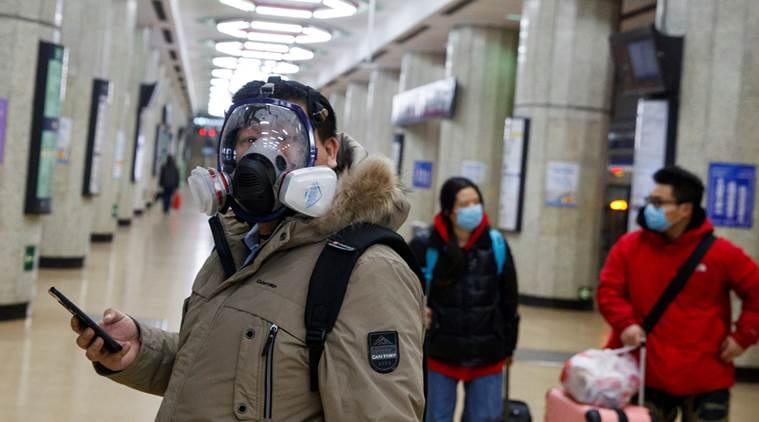 A passenger passes through a gate as a worker uses disinfectant to clean it as a precaution against COVID-19 at a metro station in New Delhi
A passenger passes through a gate as a worker uses disinfectant to clean it as a precaution against COVID-19 at a metro station in New DelhiWith the Centre allowing gradual resumption of metro train services across the country, the journey in a metro will not be the same for commuters and is set to transform dramatically in a post-Covid world. Mandatory wearing of masks, thermal screening at entry gates, leaving alternate seats vacant and social distancing for standing passengers — these are among the many guidelines being mooted by authorities to prevent the spread of Covid-19.
While restoring riders’ confidence will remain a challenge in the near future, for some cities like Delhi, where the metro is considered the city’s lifeline, the resumption of services is also closely knit with economic recovery.
In Europe and in the United States, metro or rapid transit services resumed operations in May, with governments imposing mandatory wearing of masks, limiting riders to enable physical distancing and staggering ridership. Many countries in Asia, Europe and North America have installed plastic screens between passengers while in Chicago, riders will soon be able to monitor crowding aboard metros through an app and adjust the timing of their trips.
Here are the measures taken by metro systems across the world:
🚇 Delhi Metro
The Delhi Metro, having a vast 389 km network, has already prepared a Standard Operating Procedure, including mandatory wearing of masks and use of smart cards instead of tokens. Besides, thermal screening will be carried out and anyone showing a high temperature or symptoms of flu will be barred from entering the station premises. Moreover, all cash transactions will be done away with temporarily and commuters will have to use credit or debit cards, e-wallets like Paytm for recharging their smart cards. A new type of smart card, called ‘Autope’, which can be linked with bank accounts, will also be available.
Alternate seats will have to be left vacant and a distance of one metre will have to be maintained between two persons standing. Moreover, trains will halt with all the doors open for a considerable time at terminal stations to allow fresh air to enter the coaches. The temperature inside the coaches will be between 24 and 28 degrees Celsius.
 Alternate seats will have to be left vacant and a distance of one metre will have to be maintained between two persons standing
Alternate seats will have to be left vacant and a distance of one metre will have to be maintained between two persons standing
🚇 Mumbai Metro
To ensure passenger safety and encourage social distancing, Mumbai Metro authorities are planning to install QR-code based entry at stations besides introducing alternative seating arrangements inside coaches. When a passenger enters a metro station, he will have to proceed to a health desk and get screened with a temperature gun. Entry and exit gates will be curtailed and masks will be made mandatory.
🚇 The United States
Several states in the US have come up with their own set of guidelines and steps to arrest the spread of Covid-19.
Besides mandating face masks and disinfecting trains at regular intervals, the Metropolitan Transportation Authority, which runs the New York subway, has in place a robust ventilation system that is effective at removing viral particles from the air. According to an NYT report, in subway trains, the filtered air that circulates through a car, is replaced with fresh air at least 18 times an hour.
To reduce rush-hour crowding, New York officials have asked businesses to stagger work hours. The transit agency has also distributed over a million masks to riders and started public service campaigns encouraging them to maintain social distance. However, the NYT report says ridership has been just 20 percent of pre-pandemic levels.
In San Francisco, the Bay Area Rapid Transit system is providing weekly crowding charts for train riders and using its Twitter and text alert system to keep riders informed.
Chicago’s transit authority has invested in UV light tools to disinfect trains and is testing new antimicrobial products to prevent bacteria, viruses, and liquids from sticking to treated surfaces for an extended period of time.
 A man wears a face mask at a metro station in Beijing (Reuters)
A man wears a face mask at a metro station in Beijing (Reuters)
🚇 Europe
Most European nations re-opened metro systems in mid May, albeit with drastically reduced ridership which has continued even in the following months.
Italy
The Milan Metro in Italy has made wearing of face masks and gloves mandatory on board, with passengers having to maintain a one-meter distance from one another. To alert authorities if maximum capacity of a train has been reached, a system is in place in most stations to automatically count passengers as they pass ticket barriers. Besides, red signs have been put to show people where they should stand on the platform to keep a safe distance from others.
France
The French government has limited the number of passengers on a metro train to 180 (a total of 32 passengers per carriage) from 700 on normal times. Wearing a face mask is compulsory for those over 11 years of age and violators can be fined up to $145. In the Ile-de-France region, travellers must carry with them a certificate from their employer that authorises them to be using public transport at rush hour.
 People wearing face masks ride a metro in Copenhagen, Denmark (AP)
People wearing face masks ride a metro in Copenhagen, Denmark (AP)
Germany
Germany was one of the first countries to reopen metro services after weeks of lockdown. Passengers are required to keep a 1.5-meter distance inside the Berlin metro system (U-Bahn) and face masks or any mouth-and-nose covering is mandatory except for children under six years.
The United Kingdom
Passengers using the London Underground are required to keep a distance of two meters from their fellow travelers even though face coverings have not been made mandatory. Moreover, to avoid rush-hour crowds and for easier planning of journeys, a new app called TfL Go has been launched. The app provides real-time train schedules and information on alternative routes.
🚇 Tokyo Metro
Tokyo Metro resumed operations when Japan lifted its lockdown in late May. To check spread of the virus, Tokyo Metro, which has a rail network of about 900 stations and 85 lines, has begun spraying its nearly 3,000 cars with a superfine atomisation of a silver-based compound, using silver’s antimicrobial properties to keep the virus off surfaces, according to a report by The Japan Times.
Moreover, it has updated its app to offer real-time information on capacity by carriage, along with crowd levels at stations.